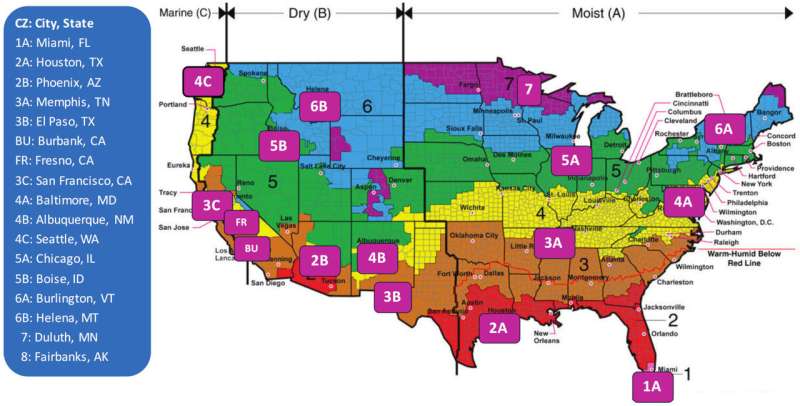Can't take the heat? 'Cool walls' can reduce energy costs, pollution

If these walls could talk, they might tell you that cutting energy costs and pollution may be as easy as giving them a fresh coat of lighter, more reflective paint.
A study by scientists at the U.S. Department of Energy's Lawrence Berkeley National Laboratory (Berkeley Lab) modeled several different types and ages of homes, retail stores, and office buildings in cities across California and the U.S., and found that in many places sunlight-reflecting "cool" exterior walls can save as much or more energy than sunlight-reflecting cool roofs.
Cool walls are generally considered to have a higher-than-average solar reflectance—which means that they reflect a higher fraction of incoming sunlight than average exterior walls—and high thermal emittance, meaning they can efficiently release absorbed heat.
"Cool walls provide energy cost savings and emission reductions across California and the southern half of the United States. In these climates, cool walls can save as much or more energy than the same size cool roof," said Ronnen Levinson, a Berkeley Lab staff scientist and leader of Berkeley Lab's Heat Island Group who co-authored the study, published in the journal Energy & Buildings. Walls receive less intense sunlight than roofs, but are also less insulated, he explained.
The study featured an analysis of more than 100,000 building simulations. Pablo J. Rosado, formerly a mechanical engineering postdoctoral fellow in the Heat Island Group, was the study's lead author.
The Heat Island Group explores the urban heat island effect—a rise in outdoor urban air temperature caused by the concentration of buildings, roads, and other structures that absorb heat—and ways to abate the problem.
"Vertical analogs to cool roofs'
Levinson said he became interested in the science of cool walls about a decade ago, while working on a cool-roof program in China. "It was obvious in Chinese cities that there was a lot more wall area than roof area," he said. "I started thinking, "Should we look at cool walls as the vertical analogs to cool roofs?""
Across most of the U.S., about 40% to 60% of all buildings were built before 1980, when building codes generally specified much less wall insulation than required today. As a result, cool-wall savings in these older buildings that meet these older codes could be three to six times greater than those for new buildings, the study found.
"Repainting the exterior walls of pre-1980 buildings—whether homes or office buildings or stores—with cool paint offers the greatest benefit because they have the least insulation," Levinson said. "And that's not difficult to do. There are many light-colored cool paints in local home supply stores."
While there is not yet a formal, universal definition for cool walls, Levinson suggests that lower-performance cool walls should reflect at least 40% of solar energy, while higher-performance cool walls should reflect at least 60%. The study assumed that an average wall that is not cool reflects 25% of sunlight.

Light-colored walls are coolest, but pigments that reflect the invisible half of sunlight and pigments that fluoresce can be used to make cool paints in a wide range of colors. Shiny, bare-metal walls tend to not be cool because they are slow to release absorbed heat.
Savings found across California and southern half of U.S.
In warm U.S. cities from Miami, Florida, to Albuquerque, New Mexico (see map: climate zones 1A to 4B), researchers found that cool walls could lead to annual heating, ventilation, and air conditioning (HVAC) energy cost savings up to 11% for stand-alone retail stores, 8.3% for single-family homes, and 4.6% for medium-sized office buildings. And for single-family homes across all California climates, the study found potential energy cost savings of 4% to 27%.
The study accounted for both energy savings in the cooling season and elevated energy costs in the heating season.
The researchers found that cool walls offer comparable reductions in annual emissions of air pollutants such as nitrogen oxides and sulfur dioxide, and greenhouse gases such as carbon dioxide. They also lower peak demand for electric power.
Levinson has also published a related study in the journal Solar Energy that shows how to adjust cool-wall savings for the effects of shading and reflection by neighboring buildings.
Early steps toward cool wall standards
There is now some momentum toward specifications and ratings for cool walls, Levinson noted.
The Cool Roof Rating Council, which was created in 1998 as a nonprofit educational organization to support research and rating systems for cool roofing products and serve as a resource for increasing energy efficiency in buildings, is pursuing an expansion into ratings for cool walls, he said.
The organization voted June 12 to amend its bylaws to permit the rating of wall surface products.
The latest study makes it clear that many places could benefit greatly from cool walls, Levinson said. "If you have a hot, sunny climate, cool walls are for you."
Cool-Wall Resources
Cool-wall benefits, technologies, and implementation are summarized in a recent Berkeley Lab-led report prepared for the California Energy Commission: Solar-Reflective "Cool" Walls: Benefits, Technologies, and Implementation.
Two other recent studies published by researchers at Berkeley Lab and the University of Southern California in the journal Environmental Science & Technology found that cool walls are nearly as effective as cool roofs for reducing the urban heat island effect, and that cool walls and roofs have mixed effects on air quality in the Los Angeles Basin.
Use the Cool Surface Savings Explorer, an Excel-based tool for Windows, to view estimated cool-surface energy savings for a variety of building types. Instructions and a download link are available in Section 4 of the Cool Wall Application Guidelines in a California Energy Commission report.
Berkeley Lab researchers have developed ruby red and Egyptian blue fluorescent cool pigments that could enhance the energy-saving properties of cool wall paints.
More information: Pablo J. Rosado et al. Potential benefits of cool walls on residential and commercial buildings across California and the United States: Conserving energy, saving money, and reducing emission of greenhouse gases and air pollutants, Energy and Buildings (2019). DOI: 10.1016/j.enbuild.2019.02.028
Ronnen Levinson et al. Methods of creating solar-reflective nonwhite surfaces and their application to residential roofing materials, Solar Energy Materials and Solar Cells (2006). DOI: 10.1016/j.solmat.2006.06.062
Paul Berdahl et al. Fluorescent cooling of objects exposed to sunlight – The ruby example, Solar Energy Materials and Solar Cells (2016). DOI: 10.1016/j.solmat.2016.05.058
Ronnen Levinson. Using solar availability factors to adjust cool-wall energy savings for shading and reflection by neighboring buildings, Solar Energy (2019). DOI: 10.1016/j.solener.2019.01.023

















